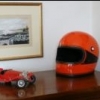
The book and its effect upon generations of readers is sufficient for it to rate a prominent place on the rather short shelf of novels with a sports car theme. For enthusiasts in Colorado, the book has a more specific interest. The Red Car is undeniably a work of fiction, but it is based upon a significant amount of Colorado historical fact. The fictional mountain hamlet of Bullet, was actually Aspen, Colorado. Scarcely three paragraphs into the first chapter, Stanford has protagonist Hap Adams gazing at “…the towering peak of Ajax Mountain”. In the 1950s Ajax Mountain was the name of what is now known as Aspen Mountain, renamed by the city when skiing on the mountain became big business.
The road race depicted in the final two chapters of the novel was composed of elements from the series of races held yearly on Aspen streets from 1951 through 1954. The Aspen road race of September 9, 1951, was the first sports car race to be held in the state of Colorado, and the author of The Red Car, Don Stanford, was a participant in that first race driving car number 4, a red 1948 MG TC. He was also one of the four instigators of the race, along with fellow Aspenite Dr. Bob Barnard, Aspen Corporation executive Lennie Woods, and Aspen hotel owner Les Gaylord.
It is not unusual for authors to incorporate their life experiences in the books they write, but it is somewhat unusual to have photographic evidence of those experiences. Included below are two images which provide evidence of Stanford’s participation in the 1951 race, and in the two incidents that form the climax of his novel.
The fictional Red Car, a red 1948 MG TC carrying car number 4, is driven in the final race by “Frenchy”, a mechanic and owner of the Bullet Garage. Frenchy is the character who serves as the catalyst for many of the events described in the book, and is Hap Adams’ mentor in the world of sports cars. Hap, the 16 year-old owner of the Red Car, is not allowed to drive in the climactic race for the prosaic reason that the event insurance policy did not allow drivers under the age of twenty-one. Hap is, however, allowed to serve as “riding mechanic” in the car.
Two laps from the end of the race, Frenchy and Hap become involved in an on-track altercation with the villain of the book, professional race driver John Arata. During the incident, Arata and his car owner and fellow conspirator Art Wister crash into and eliminate one another. In the tumult Frenchy and Hap crash into hay bales placed nearby.
This photograph shows the real Red Car driven by Don Stanford and carrying his co-driver, a young woman named Alice, striking the hay bales in the Sept. 9, 1951 race in Aspen.

1951 Denver Post photo courtesy Aspen Historical Society
As a result of the crash, the fictional Red Car’s right rear fender is torn loose. The damaged fender rubs against the tire, causing Frenchy to exclaim that they must abandon the race because it will soon cut the tire. Hap shows his true hero’s grit by reaching across the back of the cockpit and grasping the edge of the fender, pulling it away from the tire. Hap hangs on to the fender for the final two laps, and the Red Car finishes … second. The race in Class F is won by an unnamed driver in a green MG TC, the Red Car having been passed on the final lap.
This photograph shows author Don Stanford finishing the race in Aspen on Sept. 9, 1951. In what must be one of the most remarkably prescient photos to be found in the long history of road racing, we see Stanford in the real Red Car crossing the finish line with his right hand grasping the forward edge of the fender damaged in the hay bale incident, while his co-driver, the sturdy and irrepressible Alice, is stretched across the back of the cockpit holding the rear edge of the fender.

1951 Denver Post photo courtesy Aspen Historical Society
Don Stanford and Alice finished third in class, and sixth overall, in their 1951 Aspen race. That event, the first sports car race held in Colorado, was won by John Johantgen in a Jaguar XK120.











